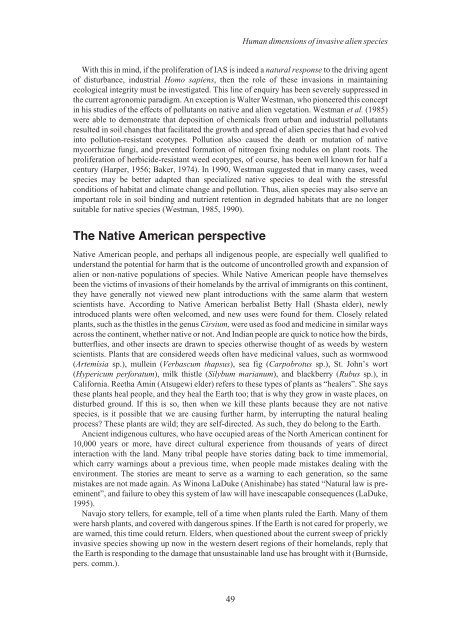Alien Species.vp - IUCN
Alien Species.vp - IUCN
Alien Species.vp - IUCN
Create successful ePaper yourself
Turn your PDF publications into a flip-book with our unique Google optimized e-Paper software.
With this in mind, if the proliferation of IAS is indeed a natural response to the driving agent<br />
of disturbance, industrial Homo sapiens, then the role of these invasions in maintaining<br />
ecological integrity must be investigated. This line of enquiry has been severely suppressed in<br />
the current agronomic paradigm. An exception is Walter Westman, who pioneered this concept<br />
in his studies of the effects of pollutants on native and alien vegetation. Westman et al. (1985)<br />
were able to demonstrate that deposition of chemicals from urban and industrial pollutants<br />
resulted in soil changes that facilitated the growth and spread of alien species that had evolved<br />
into pollution-resistant ecotypes. Pollution also caused the death or mutation of native<br />
mycorrhizae fungi, and prevented formation of nitrogen fixing nodules on plant roots. The<br />
proliferation of herbicide-resistant weed ecotypes, of course, has been well known for half a<br />
century (Harper, 1956; Baker, 1974). In 1990, Westman suggested that in many cases, weed<br />
species may be better adapted than specialized native species to deal with the stressful<br />
conditions of habitat and climate change and pollution. Thus, alien species may also serve an<br />
important role in soil binding and nutrient retention in degraded habitats that are no longer<br />
suitable for native species (Westman, 1985, 1990).<br />
The Native American perspective<br />
Native American people, and perhaps all indigenous people, are especially well qualified to<br />
understand the potential for harm that is the outcome of uncontrolled growth and expansion of<br />
alien or non-native populations of species. While Native American people have themselves<br />
been the victims of invasions of their homelands by the arrival of immigrants on this continent,<br />
they have generally not viewed new plant introductions with the same alarm that western<br />
scientists have. According to Native American herbalist Betty Hall (Shasta elder), newly<br />
introduced plants were often welcomed, and new uses were found for them. Closely related<br />
plants, such as the thistles in the genus Cirsium, were used as food and medicine in similar ways<br />
across the continent, whether native or not. And Indian people are quick to notice how the birds,<br />
butterflies, and other insects are drawn to species otherwise thought of as weeds by western<br />
scientists. Plants that are considered weeds often have medicinal values, such as wormwood<br />
(Artemisia sp.), mullein (Verbascum thapsus), sea fig (Carpobrotus sp.), St. John’s wort<br />
(Hypericum perforatum), milk thistle (Silybum marianum), and blackberry (Rubus sp.), in<br />
California. Reetha Amin (Atsugewi elder) refers to these types of plants as “healers”. She says<br />
these plants heal people, and they heal the Earth too; that is why they grow in waste places, on<br />
disturbed ground. If this is so, then when we kill these plants because they are not native<br />
species, is it possible that we are causing further harm, by interrupting the natural healing<br />
process? These plants are wild; they are self-directed. As such, they do belong to the Earth.<br />
Ancient indigenous cultures, who have occupied areas of the North American continent for<br />
10,000 years or more, have direct cultural experience from thousands of years of direct<br />
interaction with the land. Many tribal people have stories dating back to time immemorial,<br />
which carry warnings about a previous time, when people made mistakes dealing with the<br />
environment. The stories are meant to serve as a warning to each generation, so the same<br />
mistakes are not made again. As Winona LaDuke (Anishinabe) has stated “Natural law is preeminent”,<br />
and failure to obey this system of law will have inescapable consequences (LaDuke,<br />
1995).<br />
Navajo story tellers, for example, tell of a time when plants ruled the Earth. Many of them<br />
were harsh plants, and covered with dangerous spines. If the Earth is not cared for properly, we<br />
are warned, this time could return. Elders, when questioned about the current sweep of prickly<br />
invasive species showing up now in the western desert regions of their homelands, reply that<br />
the Earth is responding to the damage that unsustainable land use has brought with it (Burnside,<br />
pers. comm.).<br />
49<br />
Human dimensions of invasive alien species












